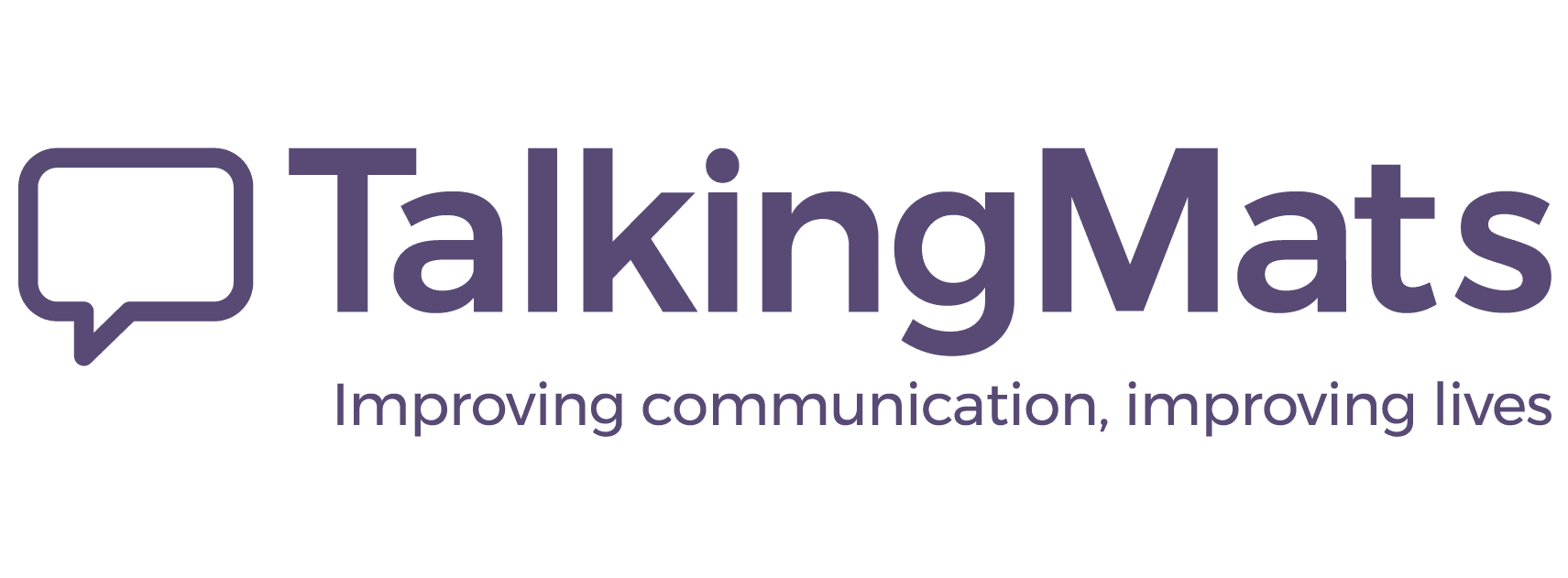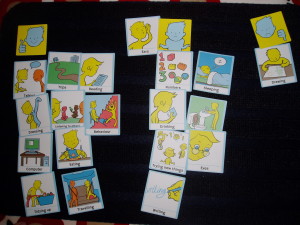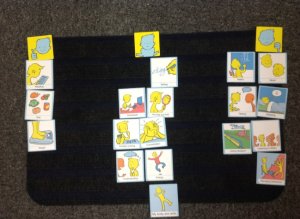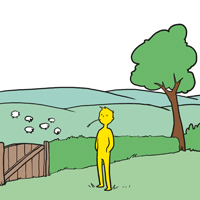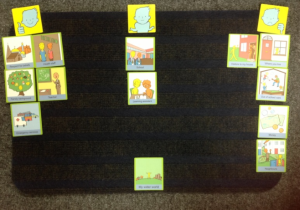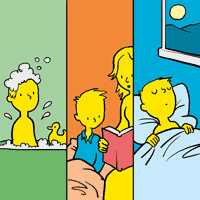I recently fell down the stairs and injured my ankle a few days before I left to visit relatives in Canada. I then had the frustrating experience of having to use a wheelchair to get through 5 airports in one day on my own. It made me realise how it all depends on communication and how reliant I was on the communication skills of the people pushing the wheelchair and how helpless I was when communication went wrong.
I had gone on-line before leaving to pre-book a wheelchair but this was confusing as each airport and airline had different rules.
It started in Edinburgh where I was directed to a calm and very competent young man who told me exactly what was happening, where he was taking me, checking if I wanted to use the ladies room or buy a coffee, helping me get through security and then to the door of the plane where I managed to hop to my seat. ‘Great’ I thought -‘This is going to be a doddle!’
Same thing happened at Heathrow with a lovely woman who chatted all the way – checked if I needed anything and told me that she had been doing this job for several years after her mother had died and absolutely loved helping people. However …. at Boston where I had to go through customs, collect my luggage and recheck in and go through security… That’s when it all went wrong.
The man who came to ‘help’ was a man of few words and despite telling him repeatedly when my next flight was due and that I didn’t have much time, he seemed totally unconcerned. He dumped my case across my knees ( heedless of my injury); he took me to the wrong terminal building despite me asking if we were we going to the Air Canada terminal; he never looked at me or asked if I was OK; he walked incredibly slowly paying no heed to me showing him the time on my boarding pass and the final straw was when he stopped at the corner of one building and said he could go no further as he only worked for transatlantic flights! He then made me get out of the wheelchair and left me to hobble to the Air Canada desk with both my check-in baggage and my hand luggage. By the time I got to the check-in desk the flight had closed and I was told I was too late and I would need to get another flight the day after!
Fortunately the Air Canada staff could see that I was struggling and persuaded the baggage handlers to accept my case as I was ‘disabled’ and I was allowed on the flight….just!
The staff at Toronto and Winnipeg airports were much more helpful but for me it was a real insight into how dependent someone in a wheelchair is and how things can either be made pleasant and smooth or can go horribly …wrong depending on people’s communication.
To mark Dementia Awareness week the Talking Mats team is keen to provide family training for relatives who care for someone with a communication difficulty.
Thanks to a generous donation from Miss Hendry Charitable Trust and support from Alzheimer Scotland, training has been carried out with family members at the Clydebank Alzheimer Scotland Resource Centre. Eight people who care for a relative with dementia (6 caring for a spouse and 2 caring for a parent) and one member of staff attended. None of the participants knew about Talking Mats before the training. They all cared for people who had difficulty expressing themselves and several told the group about the frustrations and despair they sometimes felt.
The training was carried out over 2 sessions.
Session 1 included an explanation to the background and purpose of Talking Mats, a demonstration, watching and discussing DVD examples, hands on practice, discussion of topics to be used at home with their relative and planning for next session.
Each participant was given a set of materials and by the end of the day all participants had understood the principles involved in Talking Mats and had gained the skills required to use it with their relative. They all said how much they had enjoyed the day and how much they had gained from it. They all committed to trying it with their relative and to bringing back their views to the follow up session. Each participant was given a post-it note at the end of the day and was asked to write any comments- positive or negative about the day.
Some of the comments:
• This was a very positive course today. It has made me feel very hopeful about establishing a time of coherent dialogue with my mother – albeit in a focused way and also in providing a tool for her to communicate in a simple way, her own thoughts, Thank you.
• Informative, informal, surprising. I enjoyed the course and felt I had gained from it.
• Could be a useful tool. Can’t wait to try it with my wife. Thank you.
• The course was very informative and well worth the time spent. Talking Mats is a very simple idea which seems to be working very well. I’m looking forward to trying it out and hearing how the others coped and what the outcomes will be.
• This was a very informative day and hopefully gives us a great way of communicating to find out my husband’s views on subjects.
The participants were assured that they could get ongoing support by phone or email and the staff member at the resource offered to provide local support.
Six participants plus two staff came to the second session. The others were unable to attend due to their relative being unwell. We had lively and helpful discussions where each person shared their own personal stories of how they had used Talking Mats and what it meant for them.
Overall they felt that Talking Mats was a powerful and helpful tool and that it gave them quality time together with their relative with dementia. The following comments illustrate this:
– small changes made a big difference
– It gives me time to sit down and listen to him
– It slows you down which is needed with someone with dementia
– It helps me know where he is at the moment
– It showed my husband the things he CAN do rather than what he CAN’T do
Relatives found out some things about their partner that they didn’t know e.g. one person with dementia had revealed that they didn’t like having the radio on all the time; another had toothache which the partner was unaware of; another said that food had become tasteless and he no longer enjoyed mealtimes as a result. The relatives were all able to do something as a result to help the situations – e.g. reduce the background noise of the radio, make a dental appointment, add more spice to their cooking.
One couple now use Talking Mats every few days on a regular basis to help the person with dementia think about issues and compare his mood from week to week
– He always feels up after he’s done a Talking Mat
This couple had also given a demonstration of using Talking Mats to a family meeting at the resource centre
Overall the participants found Talking Mats very helpful although two felt it had not been successful. We discussed the reasons for this and the group were very supportive and suggested that the staff could help by introducing Talking Mats as a group activity at the resource centre where these two people could be included. The staff at the centre were also very positive and plan to use Talking Mats both with individual people and with groups.
Overall it was agreed that Talking Mats is a very useful tool both for individual families and for dementia centres. We discussed future plans for individuals and also for the centre. This included designing a Talking Mat to discuss football and another to allow the people with dementia who attend the centre to be involved in planning the centre’s new allotment.
We plan to continue our involvement with the Clydebank Resource Centre and are now in the middle of running the same course in other Dementia Resource Centres.
Anyone wishing further information about Talking Mats training for family members, please contact us at info@talkingmats.com
Talking Mats has adopted day 69 of the justice for LB Campaign. This campaign was started was after Connor Sparrowhawk drowned in the bath whilst staying in an assessment treatment unit . In the words of his mum Connor was ‘a beautiful, hilarious and loved beyond words dude’. So, after decades of trying to improve services for people with learning disability, closing the long stay hospitals, bringing in person centred approaches, we are left in 2014 with huge inequalities in the health and life opportunities for people with learning disability and life’s like Connor are cut short in such a shocking, unnecessary and untimely manner.
How many more tragic deaths are we going to see before residential services for people with learning disability are going to change? We need to see at the heart of service culture an ability to really listen , put the views of the patient at the heart of planning and see the families as key partners. Sometimes I think people see listening as a ‘soft issue’. Other things get measured but does the quality of listening ever get measured? It should because in my view it is a critical patient safety issue.
Over the last few years I have had the privileged of working with a diverse group of people with a range of communication support needs. They have developed an interactive workbook for NHS Education Scotland. They share their experiences of contact with services to help staff understand how to improve communication and listening skills. They created 10 vision statements for staff of the things that were key to them. They told powerful personal stories to illustrate those statements. The stories illustrate both good and bad practice. You can download the free resource at http://goo.gl/QdOOev .
Listening to people what strikes me time and time again is the lottery of service delivery. There are some great stories where people have received quality treatment and interaction but that is not universal for there are stories where you are left questioning the compassion and humanity of staff in so called ‘caring’ roles. The question for all of us is how we shift the culture so that we can all experience a person centred and listening health service. I hope the energy and impetus of #107 campaign ignites the flame of change so that ‘all dudes’ gets a safe and quality service. If you want to join the campaign then please follow @justiceforLB .
Many thanks to Lynne Baxter who has answered the question: Is Talking Mats suitable for parents to use?
I have been asked to write an account of my experience, as a parent, of completing the on-line course available for Taking Mats. I completed this course in April this year 2014 and I am very proud of my achievement. First some background information. I am nobody special just a parent of a child who has a diagnosis of Autism Spectrum Disorder/Condition. My son is in a mainstream setting and has limited access to support and resources due to financial restrictions. Through time I realised that I was his main resource for support and really needed to improve my knowledge and understanding of this “hidden disability”. I had already heard about the wonderful resource that is Talking Mats, the tool that help makes communication easier for many. I started to do my research and find out more about it. I am not a professional who has been trained on the Autism Spectrum, my knowledge is only from my experience of having a child on the spectrum. I was unsure if I would be able to do this. After much consideration I took the decision to give it a try! I am so glad I did. While insuring that the product would be of benefit to my family, I nervously contacted the wonderful supportive team at Talking Mats and asked them what they thought. They were very encouraging and I felt empowered to try the training course! They assured me that they would help me as much as they could. This was very reassuring to know and gave me the reinforcement I was looking for.
Every week I was given access to each module which I completed to the best of my ability. Anxiously waiting for the result and the feedback from the team to see if I was able to attempt the next module was normal for a Wednesday while doing this course. To my great relief the feedback was positive and before I knew it I was nearing the last assessment and the completion of the course. The last assessment involved me and my son using the resource Talking Mats, this had to be filmed and sent for grading! Once again I had to push myself out of my comfort zone! It will be worth it for the benefit the training would give to my family. A friend came and videoed the situation and it was sent off for feedback and grading.
I passed! The feedback was amazing and now I can use the resource that will help my son explain his thoughts and feelings in a concrete way. The hardest thing for me was not to influence the results, I had to make sure it was his views and not mine! I have now registered to use the app and I am continually surprised by the evidence. I am delighted with the continued support from the team and I am very grateful to them for the resource. My son finds it hard to express his emotions, thoughts and feelings. This gives me hard evidence of his opinions and is great to have to reference too throughout the years!
Having to use open questions has helped my son communicate more than he knows! A very good result!
For information about the online training click here
I am a parent of a child in Primary one. We are expected to take our child along to the parent / teacher consultation meetings. After our first meeting I felt dissatisfied and no more informed. As a shy primary one, Eilidh gave no verbal feedback in the meeting, I felt I couldn’t voice any real concerns I had in case I knocked Eilidh’s confidence and the teacher was probably in a similar situation. Instead everyone was very nice but I left without any plan of action and no feeling that Eilidh’s teacher knew how she was feeling about her progress at school.
This time, I plan to be more prepared and to make sure Eilidh is properly at the heart of the consultation. I decided this time to use the new ‘Consulting Children and Young People’ pack, and felt the ‘my body and skills’ section was ideal for thinking about the key aspects of school life.
Eilidh engaged immediately with the mat and seemed confident with what the symbols represented. By the end of the mat and after going over it with her and checking if there was anything we had missed, I feel we have a really good starting point for discussion when we attend the meeting on Thursday.
The key points were:
Eilidh is most concerned about her drawing skills. Her face dropped when she saw the card. She perked up a little when she looked at the symbol as she decided she was good at drawing sunshine but not people. On discussion it turned out she really wants to be able to draw clothes on people. We talked about what we could do and decided she could do drawing practice with her dad (who is much better than me!). She was happy with this and has since already drawn a fully clothed person!
She is a bit unsure about numbers, writing and trying new things. These are things to discuss with the teacher but it shows her awareness of where she needs more support. Going to the toilet and drinking water both require her to ask the teacher for permission and she put those in the middle as she doesn’t always like to ask and often comes home with a full water bottle. This is something we can bring up and hopefully the teacher can reassure Eilidh it is fine to ask.
Finally, we were able to finish on a high as we acknowledged that she has really increased her confidence in talking (at school), reading and getting dressed independently. Again it really shows how aware she is of her own abilities and what she has struggled with in the past.
I would really recommend using the pack for this purpose. If I have time before the meeting I plan to use the other symbol sets to explore how she is feeling about the people at school (friends / teachers / support staff). By Morag Place
Eilidh’s Mat
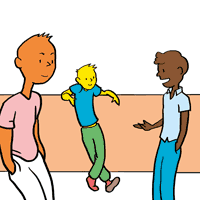
Tina is a 13 year old girl who initially had coped well with the transition to High School but in February had started to refuse to come to school. She was unable to explain what the problem was and when asked about the reason for her absence, would say “ I hate school”.
The “Consulting children and Young people -secondary resource” was used to consult with Tina. She was presented with some of the options from “My body and Skills” to think about how she was feeling. Tina used the top scale Happy(Things are going well and Not happy (things are not going well).
During the Talking Mats interview she opened up about how she felt about travelling to school (she hated going on the school bus and felt embarrassed) She clearly identified the fact that she has specific learning needs as she has difficulty understanding and concentrating in class and often falls behind with her written work. Attending her maths class was particularly difficult and she did her best to avoid going. She also talked about her difficulty with talking to adults and also to her peers. Often she feels excluded in conversations as although she is listening, she doesn’t always understand what they are discussing and doesn’t know what to say. She has a problem with sleeping and feels her mood is low a lot of the time. She also commented that she can feel extremely angry and this has a negative effect on her behaviour. On the positive side, she loves to read and feels happy about her diet and her weight.
Helping Tina to grade her feelings about specific issues helped to identify what needed to be done in the first instance to get her back to school.
Alternative travel arrangements were put in place, extra support provided for her in class and from the learning support base.
She is attending school again and the pupil support team are gathering together the appropriate “team around the child” to explore her difficulties further.
Find out more about how to use Talking Mats by signing up for a training course at Talking Mats.
The communities where children grow up can have a significant impact on the well-being of both children and families. The Consulting Children and Young people pack contains the topic “My Wider World”. This topic allows exploration of the impact of both school and life out of school as well as the support systems available to them. The World Health Organisation reminds us of the importance of gathering environmental information from children. As a child develops the environments of their everyday life are closely connected to home and school and finding out how the child feels will give insight into their independence and activity. Negative environmental factors often have a greater impact on children than on adults. In order to promote a child’s well-being, effort needs to be given to enhancing a child’s physical environment as well as their social or psychological environment.
Daniel is an 11 year old boy with a diagnosis of Asperger’s Syndrome. He completed a Talking Mat to explore the impact of his environment on his condition. He was asked to grade his responses using the top scale Happy (Things are going well) and Not happy (things are not going well).
He immediately commented about how he felt about school (“yeah –it’s okay”) He expressed a strongly negative reaction when asked about where he lived. He was very unhappy about the location of his house as it is in an extremely remote location and he can never have any friends round to play. He never gets visitors to his house apart from an uncle that may drop by. He feels bad that he doesn’t have any neighbours and would love to live somewhere that has got other houses nearby. He has talked to his mum about it but she says, “she can’t take me places – too much petrol” He knows that his mum is worried about money. He also really dislikes “out of school care” as he is rarely allowed to play on the computer. He is happy with his teacher, support from health services and the emergency services.
Daniel was clearly upset about his lack of social integration and contact with his wider community.
Environmental support included supporting the care-givers in the “out of school club” by providing training and advice about Asperger’s Syndrome.
Social work became involved to help to help locate local youth groups and finance.
Find out more about how to use Talking Mats by signing up for a training course at Talking Mats.
Talking Mats is fun! Whether you are sitting on the floor completing your mat or sitting at a small table, young children enjoy the fact that they can give information through multiple channels – Talking Mats is visual, auditory and tactile. It is an engaging tool to use when consulting children.They can express a view without words if they want to or they can have a conversation if they enjoy chatting. Watching a young child thinking and reflecting about where they place their symbol on the mat can be a humbling experience. Some adults still consider young children as incapable of expressing their views or opinions but in reality they can often express strong views about things and are very capable of grading their responses. Sometimes we just don’t take the time to ask them about the issues in their lives and free up some time to listen.
Talking Mats has created a specific Early years resource to make consulting young children easier. The symbols have been graded according to their developmental stage. When using the picture symbols it is important to remember:
- Most of the symbols in the Early years pack are concrete and you can quickly identify the shared meaning for example – “drawing”
- Others are concrete but have a broader meaning. An example of this is when asking about “eyes”
We have found that it is best to allow the child to interpret the meaning at their level so it maybe they have sore eyes; they don’t like their glasses or they have brown eyes. Try not to be too prescriptive when presenting the option to the child; a symbol can act as a jump off point capturing what fits for the child at the time. Just allow the meaning to emerge.
• The abstract symbols do need a bit more explanation because they ask about more complex concepts such as safety. The Early years pack asks about safety in relation to the road, physical safety and safety around others.
Asking about daily routines will give insight into how nurtured and cared for they feel. Let the child lead the discussion as much as possible.
Using visual communication is a great way to have a conversation with children in the early years and a good tool to involve children in decision making. Listening to the child’s view is essential for the GIRFEC process in Scotland and for co-producing Education Health care plans in England and Wales. Talking Mats has created a unique resource which is based on the “International Classification of Functioning, Disability and Health – Children and Youth version” Talking Mats uses a framework which helps children to express themselves in a way they feel comfortable with. As adults we need to be able to facilitate the conversation.
We find that to realize the full potential of Talking Mats it is best to attend a Talking Mats course . The courses allow you to focus on your situation and how you can be creative and apply it in your own work,
We are frequently asked if Talking Mats can be used by someone who is blind and we usually say ‘not really as its essentially a visual tool’. However today I had to eat my words when I was interviewed by Ian Hamilton who is a BBC Scotland TV and radio reporter. Ian is totally blind and was accompanied by his guide dog – a very large but gentle German Shepherd called Renton. Here is a link about Ian and Renton
When Ian asked me to explain Talking Mats I guided his hand to the positioning of the 3 top scale symbols and then he immediately understood the layout of the top scale, the topic at the bottom of the mat, and where to place each option by touch. I simply explained each symbol, placed it in his hand and he did the rest. The topic was how Ian feels about Domestic Life and we had a lot of laughs about his dislike of shopping, laundry and cleaning. He explained that shopping was a nightmare for someone who is blind. He said that the dislike of laundry and cleaning showed that he was lazy – I think it’s pretty much what lots of people think!
However he was clear about a number of things that he feels very positive about, in particular his daily routine and his security, both of which are very important because of his blindness. Interestingly he said that his guide dog is clearly on the positive side of the mat, but not as a pet. A dog like Renton is not just a form of mobility, he’s also a fantastic companion.
Ian seemed to keep 1 step ahead of me and asked loads of great questions about Talking Mats as a thinking tool and its possibilities for other groups of people. He commented that, like inventions such as the typewriter and the phone, Talking mats is something originally intended for people with a disability, but which is now being used by people of all abilities to help them consider issues and then express their views.
Ian generously agreed to me writing this blog and using his photo.
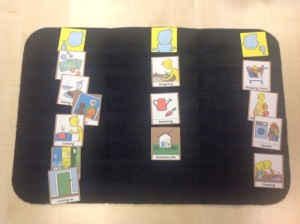
The programme will be broadcast on BBC Radio Scotland : Business Scotland on 24th and 25th May
During a research project funded by the Joseph Rowntree Foundation in 2007, Joan Murphy and Cindy Gray developed the Dementia Communication Difficulties Scale (DCDS) to help identify the communication difficulties that a person with dementia might be having and therefore help carers and staff to understand these difficulties and therefore support the person with dementia. The scale comprises 13 statements that are based on existing definitions of the communication problems commonly experienced by people as dementia progresses (Kempler, 1995; Health Education Board for Scotland, 1996):
In early stage dementia, the person
- may have difficulty coming up with words
- may tend to digress and repeat themselves.
In moderate stage dementia, the person
- may find it hard to understand what is said to them, particularly when being given complex information
- may have difficulty maintaining a conversation topic without losing track
- may use semantically empty words (e.g. thing, stuff) in place of content words
- may be difficult to understand.
In late stage dementia, the person
- may make little sense
- may not be able to understand what is said to them, even when simple language is used
- may often repeat what other people have said to them
- may communicate mainly in non-verbal ways
The DCDS requires a third party who knows the person with dementia well (a paid carer or family member) to assess various aspects of their communication on a 5-option scale. People are asked to circle the option that most closely describes the person in question.
Each DCDS option is assigned a score: for example ‘Never’ = 0, ‘Sometimes’ = 1, ‘Often’ = 2, ‘Always’ or ‘Says too little for me to judge’ = 3. A person’s DCDS rating is obtained by totalling their scores for all 13 statements. DCDS ratings can therefore range from 0-39, with a higher rating indicating a greater degree of communication difficulty.
The following stages of dementia group definitions were produced:
• DCDS ratings between 0 and 10.5 = early stage
• DCDS ratings between 11 and 19.5 = moderate stage
• DCDS rating between 20 and 39= late stage.
The Dementia Communication Difficulties Scale is brief, straightforward and quick to complete, and may therefore provide a highly useful tool for the care staff, clinicians and practitioners involved in assessing the needs of people with dementia.
If you would like a copy of the scale please click here: Dementia Communication Difficulties Scale
References:
Kempler, D. (1995). Language Changes in Dementia of the Alzheimer Type. In R. Lubinski (Ed.), Dementia and Communication, San Diego: Singular Publishing Group.
Health Education Board for Scotland (1996). Coping with Dementia: A Handbook for Carers. HEBS.
 Online training login
Online training login 